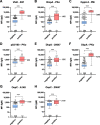Borrelia multiplex: a bead-based multiplex assay for the simultaneous detection of Borrelia specific IgG/IgM class antibodies
- PMID: 36396985
- PMCID: PMC9670078
- DOI: 10.1186/s12879-022-07863-9
Borrelia multiplex: a bead-based multiplex assay for the simultaneous detection of Borrelia specific IgG/IgM class antibodies
Abstract
Background: Lyme borreliosis (LB) is the most common tick-borne infectious disease in the northern hemisphere. The diagnosis of LB is usually made by clinical symptoms and subsequently supported by serology. In Europe, a two-step testing consisting of an enzyme-linked immunosorbent assay (ELISA) and an immunoblot is recommended. However, due to the low sensitivity of the currently available tests, antibody detection is sometimes inaccurate, especially in the early phase of infection, leading to underdiagnoses.
Methods: To improve upon Borrelia diagnostics, we developed a multiplex Borrelia immunoassay (Borrelia multiplex), which utilizes the new INTELLIFLEX platform, enabling the simultaneous dual detection of IgG and IgM antibodies, saving further time and reducing the biosample material requirement. In order to enable correct classification, the Borrelia multiplex contains eight antigens from the five human pathogenic Borrelia species known in Europe. Six antigens are known to mainly induce an IgG response and two antigens are predominant for an IgM response.
Results: To validate the assay, we compared the Borrelia multiplex to a commercial bead-based immunoassay resulting in an overall assay sensitivity of 93.7% (95% CI 84.8-97.5%) and a specificity of 96.5% (95%CI 93.5-98.1%). To confirm the calculated sensitivity and specificity, a comparison with a conventional 2-step diagnostics was performed. With this comparison, we obtained a sensitivity of 95.2% (95% CI 84.2-99.2%) and a specificity of 93.0% (95% CI 90.6-94.7%).
Conclusion: Borrelia multiplex is a highly reproducible cost- and time-effective assay that enables the profiling of antibodies against several individual antigens simultaneously.
Keywords: Borrelia; Immunoassay; Lyme Disease; Lyme borreliosis; Multiplex; Serology.
© 2022. The Author(s).
Conflict of interest statement
NSM was a speaker at Luminex conferences in the past. The Natural and Medical Sciences Institute at the University of Tübingen is involved in applied research projects as a fee for services with Luminex Corporation. The other authors declare no competing interests.
Figures





Similar articles
-
The Performance of Nine Commercial Serological Screening Assays for the Diagnosis of Lyme Borreliosis: a Multicenter Modified Two-Gate Design Study.Microbiol Spectr. 2022 Apr 27;10(2):e0051022. doi: 10.1128/spectrum.00510-22. Epub 2022 Mar 17. Microbiol Spectr. 2022. PMID: 35297658 Free PMC article.
-
Predictive value of Borrelia burgdorferi IgG antibody levels in patients referred to a tertiary Lyme centre.Ticks Tick Borne Dis. 2018 Mar;9(3):594-597. doi: 10.1016/j.ttbdis.2017.12.014. Epub 2017 Dec 24. Ticks Tick Borne Dis. 2018. PMID: 29422448
-
Persistent Anti-Borrelia IgM Antibodies without Lyme Borreliosis in the Clinical and Immunological Context.Microbiol Spectr. 2021 Dec 22;9(3):e0102021. doi: 10.1128/Spectrum.01020-21. Epub 2021 Dec 22. Microbiol Spectr. 2021. PMID: 34937165 Free PMC article.
-
Diagnosis of lyme borreliosis in europe.Vector Borne Zoonotic Dis. 2003 Winter;3(4):215-27. doi: 10.1089/153036603322662200. Vector Borne Zoonotic Dis. 2003. PMID: 14733674 Review.
-
Diagnostic Testing for Lyme Disease.Infect Dis Clin North Am. 2022 Sep;36(3):605-620. doi: 10.1016/j.idc.2022.04.001. Infect Dis Clin North Am. 2022. PMID: 36116838 Review.
Cited by
-
Development of a Duplex Serological Multiplex Assay for the Simultaneous Detection of Epstein-Barr Virus IgA and IgG Antibodies in Nasopharyngeal Carcinoma Patients.Cancers (Basel). 2023 Apr 30;15(9):2578. doi: 10.3390/cancers15092578. Cancers (Basel). 2023. PMID: 37174042 Free PMC article.
-
Particle ID: A Multiplexed Hydrogel Bead Platform for Biomedical Applications.ACS Appl Mater Interfaces. 2023 Dec 6;15(48):55346-55357. doi: 10.1021/acsami.3c12122. Epub 2023 Nov 20. ACS Appl Mater Interfaces. 2023. PMID: 37982803 Free PMC article.
-
Borrelia surface proteins: new horizons in Lyme disease diagnosis.Appl Microbiol Biotechnol. 2025 Jul 1;109(1):156. doi: 10.1007/s00253-025-13490-6. Appl Microbiol Biotechnol. 2025. PMID: 40590992 Free PMC article. Review.
-
Lyme borreliosis diagnosis: state of the art of improvements and innovations.BMC Microbiol. 2023 Aug 1;23(1):204. doi: 10.1186/s12866-023-02935-5. BMC Microbiol. 2023. PMID: 37528399 Free PMC article. Review.
References
-
- Hunfeld K-P. Borrelien. In: Suerbaum S, Burchard G-D, Kaufmann SHE, Schulz TF, editors. Medizinische mikrobiologie und infektiologie. Berlin: Springer; 2020. pp. 487–498.
-
- Müllegger R. Infektionen: Lyme-Borreliose, Leptospirose und Rückfallfieber. In: Plewig G, Ruzicka T, Kaufmann R, Hertl M, editors. Braun-Falco’s dermatologie, venerologie und allergologie. Berlin: Springer; 2018. pp. 215–231.
MeSH terms
Substances
LinkOut - more resources
Full Text Sources
Medical

